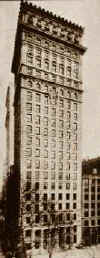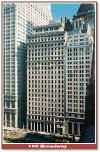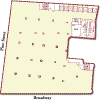 |
New York
Architecture Images- Lower Manhattan American Surety Company (now Bank of Tokyo) Landmark |
|
architect |
Bruce Price |
|
location |
100 Broadway, at Pine Street. |
|
date |
1895 |
|
style |
Neo-Classicism 2 |
|
construction |
103.0 m |
|
type |
Office Building |
|
|
|
|
images |
   |
|
|
|
|
notes |
This early skyscraper--a steel-framed office building--helped establish the
tall office building in New York. The tripartite organization of its white
limestone facade echoes the organization of a classical column, revealing
the aesthetic influence of Beaux Arts architecture as filtered through the
technical inspiration of the Chicago School.
100 Broadway (formerly known as The American Surety Company Building) was erected to designs of the eminent architect Bruce Price between 1894 and 1896. Prominently sited at the southeast corner of Broadway and Pine Street, opposite Trinity Church, the building stands in the heart of the financial district. At the time of its erection, it was the second highest building in the city. This was the first and most important tall building by Price and reflected his innovative ideas about skyscraper design. It was one of the first buildings in the city to incorporate structural techniques such as steel framing, curtain wall construction, and caisson foundation piers that carry a cantilevered steel foundation structure. Clad in Maine granite, the twenty-four story building features a rich neo-Renaissance decorative scheme that incorporates Greek elements such as the Ionic entrance colonnade and the severe classical sculptural figures, designed by J. Massey Rhind, at the third story. Credited by the noted architectural critic Montgomery Schuyler with popularizing the tripartite column analogy for tall buildings, Price's design for the edifice set a model for tall buildings on corner sites on the 1890's and was a prototype for the freestanding tower skyscrapers of the early twentieth century. Between 1920 and 1922, the building was modified with the addition of four bays on Broadway and four bays on Pine Street and by the addition of two penthouse stories. Designed by the New York architect Herman Lee Meader, these additions matched Price's original designs in material and articulation. The building was renovated for the Bank of Tokyo between 1973 and 1976, at which time the windows were replaced and an open arcade was created along Broadway. Further renovations and improvements were made by Hiro Enterprise U.S.A., Inc. between 1997 and 1998. The building was declared an historic landmark on June 24, 1997. |